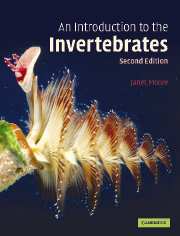Book contents
- Frontmatter
- Contents
- List of boxes
- Preface
- Acknowledgements
- Illustration acknowledgements
- Chapter 1 The process of evolution: natural selection
- Chapter 2 The pattern of evolution: methods of investigation
- Chapter 3 Porifera
- Chapter 4 Cnidaria
- Chapter 5 On being a worm
- Chapter 6 Platyhelminthes and Acoelomorpha
- Chapter 7 Nemertea
- Chapter 8 Nematoda
- Chapter 9 Annelida
- Chapter 10 Mollusca: general and Gastropoda
- Chapter 11 Mollusca: Bivalvia and Cephalopoda
- Chapter 12 Arthropoda: general
- Chapter 13 Crustacea
- Chapter 14 Chelicerata and Myriapoda
- Chapter 15 Insecta
- Chapter 16 Animals with lophophores
- Chapter 17 Echinodermata
- Chapter 18 Invertebrate Chordata and Hemichordata
- Chapter 19 Development
- Chapter 20 Invertebrate evolutionary history
- Further reading
- Glossary
- Index
Chapter 19 - Development
Published online by Cambridge University Press: 05 September 2012
- Frontmatter
- Contents
- List of boxes
- Preface
- Acknowledgements
- Illustration acknowledgements
- Chapter 1 The process of evolution: natural selection
- Chapter 2 The pattern of evolution: methods of investigation
- Chapter 3 Porifera
- Chapter 4 Cnidaria
- Chapter 5 On being a worm
- Chapter 6 Platyhelminthes and Acoelomorpha
- Chapter 7 Nemertea
- Chapter 8 Nematoda
- Chapter 9 Annelida
- Chapter 10 Mollusca: general and Gastropoda
- Chapter 11 Mollusca: Bivalvia and Cephalopoda
- Chapter 12 Arthropoda: general
- Chapter 13 Crustacea
- Chapter 14 Chelicerata and Myriapoda
- Chapter 15 Insecta
- Chapter 16 Animals with lophophores
- Chapter 17 Echinodermata
- Chapter 18 Invertebrate Chordata and Hemichordata
- Chapter 19 Development
- Chapter 20 Invertebrate evolutionary history
- Further reading
- Glossary
- Index
Summary
Development of an individual organism (ontogeny) begins with a single cell, most commonly a fertilised egg. To make a multicellular organism this cell must repeatedly divide, and the daughter cells must grow and become different from each other. Cells must move as they become organised into a body. Development depends upon the coordinated behaviour of cells, and must produce the right sort of animal every time. The main processes of earliest development (briefly introduced in Box 5.2) are discussed in this chapter, using many different examples (occasionally even vertebrates). To control the diversity of development and to bring out general features, four main examples are used: the mollusc (freshwater snail) Lymnaea, the echinoderm (sea urchin) Echinus, the nematode Caenorhabditis (C. elegans) and the insect (fruit fly) Drosophila. Development is directly or indirectly under the control of genes at every step: our growing understanding of this control is introduced at the end of the chapter.
How do animals develop?
Cell division: cleavage, the earliest divisions of the fertilised egg, proceeds by DNA replication and subdivision of the cytoplasm, normally without any increase in size (growth occurs later).
Cell differentiation is preceded by commitment (sometimes called ‘determination’), which is the limitation of developmental capacity, directing the cell to a particular pathway. This may happen long before there are any visible signs of differences between cells, and the timing of commitment in relation to cleavage varies in different kinds of animal.
Gastrulation follows cleavage. It is a series of cell movements bringing the cells that will form internal organs to the inside of the developing embryo.
[…]
- Type
- Chapter
- Information
- An Introduction to the Invertebrates , pp. 247 - 262Publisher: Cambridge University PressPrint publication year: 2006



